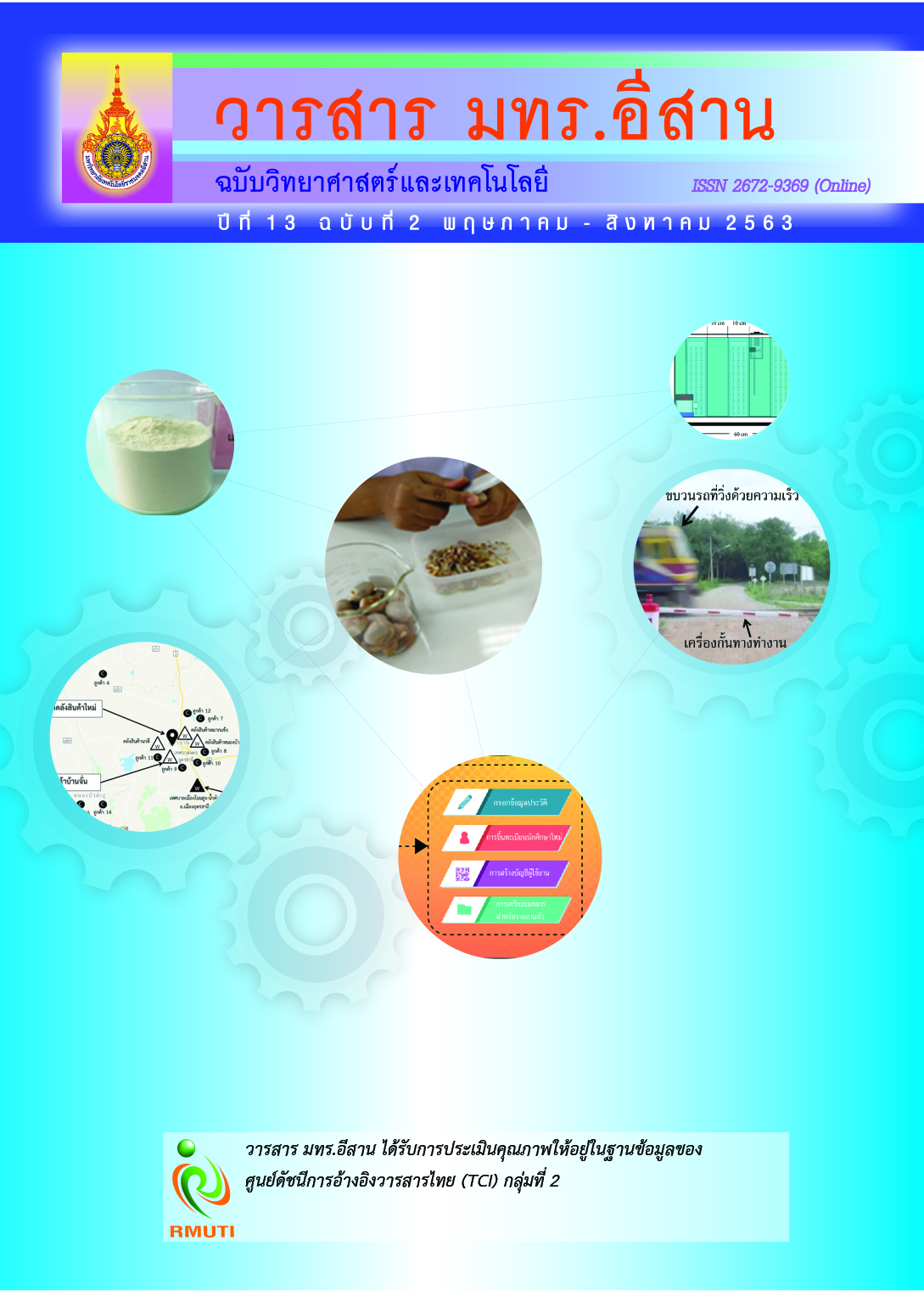The Study of the Appropriate Proportion of Black Sesame and Types of Sweetener for the Quality of Black Sesame Egg Custard Sauce
Main Article Content
Abstract
The study aimed at studying the results of the amount of black sesame and types of sweetener replacement such as stevia and sucralose on the sensory quality, physical quality, the nutrition property and the customers’ satisfaction. The three recipes of black sesame egg custard sauce with the proportion of 5, 10 and 15 % were set. The sensory evaluation result showed that the scores of the sensory quality in terms of colors, tastes, and preferences were higher in black sesame egg custard sauce with the proportion of 10 % than the ones with 5 % and 15 %. Stickiness and color value (a*) significantly increased, while color value (L*) significantly decreased (p ≤ 0.05) with increasing the proportions of black sesame. Also, the results from the two types of the sweetener replacements, namely sucralose and stevia, showed that the 10 % black sesame egg custard sauce with sucralose was more popular among the panelist than the black sesame egg custard sauce with stevia in terms of the sweetness, and the overall preferences were significantly different (p ≤ 0.05). However, stickiness value (L* a* b*) was not significantly different (p ≤ 0.05). The results regarding to its nutrition property revealed that black sesame egg custard sauce with sucralose contained nutrition property in terms of calories, fat, carbohydrate, protein, dietary fiber, moisture, ash, total sugar, calcium, iron, and phosphorus (200.33 Kcal, 13.33 g, 12.76 g, 7.33 g, 5.05 g, 64.98 g, 1.60 g, 4.05 g, 394.57 mg, 1.57 mg and 218.15 mg). The results of the customers’ satisfaction revealed that the participants accepted the product in a high acceptance level. 90 % of them would buy the product if it were launched into the market and 45 % stated that the product could be considered as healthy products.
Article Details
References
SME Cheechongruay. (2019). Pungpunglava Franchise Khanompungsaitaluk Longtoonngai Kumraigurnkrung. Access (18 March 2020). Available (http://cheechongruay.smartsme.co.th/content/22264)
Daedkhulchon, J. (2014). Thai Dessert Book 2. Bangkok: Diamond Publisher
Bureau of Nutrition, Department of Health. (2011). Good Health Starts at Foods Reduce Sweet, Salty, add More Vegetables, Fruits. In: Saleepan, S., and Sukjai, S. (eds.). Bangkok: Veterans Organization Printing Factory.
Kee-ariyo, C., Apinya, M., Photchanee, B., and Nanoln, D. (2012). The Development Thai Dessert form Local Herbs. Research Report, Faculty of Home Economics Technology, Rajamangala University of Technology Phra Nakhon
Mekrawee, N., Teeranuch, C., Onanong, T., Narongchai, K., and Kraiyarach, P. (2016). Tofu Egg Custard Sauce with Black Sesame. Home Economics Journal. Vol. 59, No. 3, pp. 26-35
Sagepakdee, N. (2001). Development of Semi-Finished Black Sesame Soup Products. Thesis Master Degree of Home Economics, Home Economics, Faculty of Agriculture, Kasetsart University
Jacob, M., Tripathi, A. M., Yadav, G., and Saha, S. (2016). Nutritive and Non-Nutritive Sweeteners: A Review. International Journal of Oral Health and Medical Research. Vol. 2, No. 5, pp. 149-153
Chermongkhl, W. (2008). Sweeteners: Use and Safety. Thai Pharmaceutical and Health Science Journal. Vol. 3, No. 1, pp. 161-168
Hemrangkha, P. (2011). The Development of Bread Sticks with Black Sesame: A Case Study of Khakai Company Limited. Thesis Master Degree of Arts, Development Strategy, Rajabhat Rajanagarindra University
Bureau of Nutrition, Department of Health. (2001). Nutritive Values of Thai Foods. In: Boonvisut, S. (eds.). Bangkok: Department of Health
AOAC. (2000). Official Methods of Analysis of AOAC International. 17th ed. Maryland, USA: AOAC International
AOAC. (2005). Official Methods of Analysis of AOAC International. 18th ed. Maryland, USA: AOAC International
Vanidbhuncha, K. (2007). Data Analysis SPSS for Windows. 10th ed. Bangkok: Thamasan Publishers Ltd.
Deveries, L. J. and Reinhold, V. N. (1992). Controlling Dietary Fiber in Food Products. New York: Van Nostrand Reinhold
Srisangwan, N. (2012). Nutritional Improvement of A-lua and Foi-Thong Desserts by Using Non sugar Sweeteners. Thesis Master Degree of Science, Food Technology, Faculty of Engineering and Industrial Technology, Silpakorn University
Khamwachiraphitak, M., Payom, R., Morragot, K., Suvitchaya, S., Kanokwan, P., Benjang, A., Songpoltanarit, M., and Benjawan, B. (2008). Influence of Fructose Syrup and Sucralose on Some Characteristics of Mixed Fruit Jams. Research Journal and Development of Valaya Alongkorn Under the Royal Patronage. Vol. 11, No. 2, pp. 15-23
Tanthipiriya, J. (2006). Partial Substitution of Sugars by Sweeteners “Sucralose” in Pomelo Jam Product. Nakhonpathom: Nakhonpathom Rajabhat University
Akesuwan, A. (2009). Quality of Reduced-Fat Chiff on Cakes Prepared with Erythritol-Sucralose as Replacement for Sugar. Pakistan Journal of Nutrition. Vol. 8, Issue 9, pp. 1383-1386. DOI: 10.3923/pjn.2009.1383.1386
Lin, S. D., Hwang, C. F., and Yeh, C. H. (2003). Physical and Sensory Characteristics of Chiff on Cake Prepared with Erythritol as Replacement for Sucrose. Journal of Food Science. Vol. 68, Issue 6, pp. 2107-2110. DOI: 10.1111/j.1365-2621.2003.tb07027.x
Vongyeam, W. (2009). Supplementing Rice Flour Cookies with Protein Extracted from Black Sesame Seeds. Thesis Master Degree of Science, Agro-Industrial Product Development, Faculty of Agro-Industry, Chiang Mai University
Klinkajorn, S. (2002). Production of Black Sesame Sesame indicum Linn. Butter. Thesis Master Degree of Science in Food Technology, Food Technology, Faculty of Science, Chulalongkorn University
Bunsit, K. and Teerapon, B. (2014). Value of Unroasted Black Sesame Seed Cake. Journal of Science and Technology, Ubon Ratchathani University. Vol. 16, No. 2, pp. 47-54
Phuksuksakul, A. (2015). Food for Family. Food and Nutrition Department, Faculty of Home Economics Technology, Rajamangala University of Technology Thanyaburi


